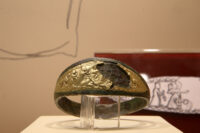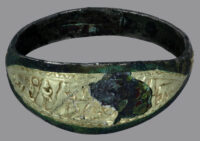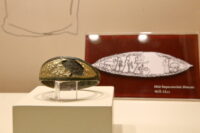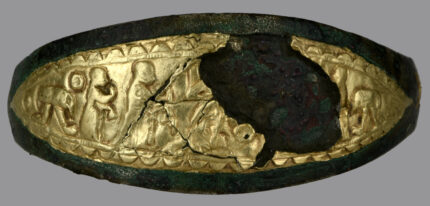 A 3,300-year-old Hittite bracelet plowed up by a farmer in Çitli village in north central Turkey’s Çorum Province is unique, the first example of a Hittite bracelet made with precious metals that has figural depictions. This is also the only Hittite bracelet with an elliptical bezel, a shape previously only found in Hittite ring seals. After extensive restoration, the bracelet is now on public display for the first time at the Çorum Archaeological Museum.
A 3,300-year-old Hittite bracelet plowed up by a farmer in Çitli village in north central Turkey’s Çorum Province is unique, the first example of a Hittite bracelet made with precious metals that has figural depictions. This is also the only Hittite bracelet with an elliptical bezel, a shape previously only found in Hittite ring seals. After extensive restoration, the bracelet is now on public display for the first time at the Çorum Archaeological Museum.
The farmer discovered the bracelet in 2011 and realized it could be an archaeological artifact. Its advanced age and rediscovery by heavy agricultural machinery had left it in parlous condition. The bracelet was misshapen and in several pieces. He collected all the parts he could find and brought them to the museum in Çorum. Museum experts were able to identify it as a Hittite-era bracelet in the preliminary examination before it was catalogued and conserved. The exact find site was unknown as the farmer had plowed five fields that day and a subsequent archaeological survey of all five of them found no additional artifacts.
 The bracelet is made of an alloy of copper, tin and arsenic, and measures 7.1 cm (2.8 inches) in diameter at the widest point. It is formed of a band moulded into an elliptical shape with the tips bent backwards and forged together to make a ring. An electrum plate mounted to the ellipse is ornamented with a relief scene of figures done in the repoussé technique. Framing the scene is a border of semicircles between lines. The plate was broken into four pieces when found; a section of the plate in the center is missing.
The bracelet is made of an alloy of copper, tin and arsenic, and measures 7.1 cm (2.8 inches) in diameter at the widest point. It is formed of a band moulded into an elliptical shape with the tips bent backwards and forged together to make a ring. An electrum plate mounted to the ellipse is ornamented with a relief scene of figures done in the repoussé technique. Framing the scene is a border of semicircles between lines. The plate was broken into four pieces when found; a section of the plate in the center is missing.
 The repoussé relief depicts the goddess Ishtar at the center of a libation procession moving inwards from both ends of the plate. The first thing on both the left and right ends of the plate is a small table or altar with curved legs terminating in an animal paw. The tables are draped with a cloth that covers the offerings they bear.
The repoussé relief depicts the goddess Ishtar at the center of a libation procession moving inwards from both ends of the plate. The first thing on both the left and right ends of the plate is a small table or altar with curved legs terminating in an animal paw. The tables are draped with a cloth that covers the offerings they bear.
On the left side, the table is followed by two female figures with no facial features processing towards the right, their right arms bent upwards and  their left carrying something. Facing them is another figure with more defined features. Her legs are in profile heading rightward, while her torso is positioned frontally. She wears a two-piece garment of skirt and mantle and on her extant right shoulder is a wing. Some of this figure is missing, but the clothing, wing and the two women following her are sufficient to identify her as Ishtar and the two female figures as her attendants Ninatta and Kulitta, a scene that has been found before in Hittite seals and rock reliefs. After the missing section are two more female figures (only the back of the head remains of one of them) facing Ishtar from the right.
their left carrying something. Facing them is another figure with more defined features. Her legs are in profile heading rightward, while her torso is positioned frontally. She wears a two-piece garment of skirt and mantle and on her extant right shoulder is a wing. Some of this figure is missing, but the clothing, wing and the two women following her are sufficient to identify her as Ishtar and the two female figures as her attendants Ninatta and Kulitta, a scene that has been found before in Hittite seals and rock reliefs. After the missing section are two more female figures (only the back of the head remains of one of them) facing Ishtar from the right.
Hattusa, capital of the Hittite Empire between 1700 BC and 1200 BC., is 70 miles southwest of the find site. It reached its greatest geographic and population peak during the reign of Suppiluliuma I (ca. 1344–1322 B.C.) right around the time when the bracelet was made.
